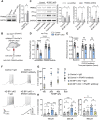4E-BP1-dependent translation in nociceptors controls mechanical hypersensitivity via TRIM32/type I interferon signaling
- PMID: 37922363
- PMCID: PMC10624345
- DOI: 10.1126/sciadv.adh9603
4E-BP1-dependent translation in nociceptors controls mechanical hypersensitivity via TRIM32/type I interferon signaling
Abstract
Activation of the mechanistic target of rapamycin complex 1 (mTORC1) contributes to the development of chronic pain. However, the specific mechanisms by which mTORC1 causes hypersensitivity remain elusive. The eukaryotic initiation factor 4E-binding protein 1 (4E-BP1) is a key mTORC1 downstream effector that represses translation initiation. Here, we show that nociceptor-specific deletion of 4E-BP1, mimicking activation of mTORC1-dependent translation, is sufficient to cause mechanical hypersensitivity. Using translating ribosome affinity purification in nociceptors lacking 4E-BP1, we identified a pronounced translational up-regulation of tripartite motif-containing protein 32 (TRIM32), an E3 ubiquitin ligase that promotes interferon signaling. Down-regulation of TRIM32 in nociceptors or blocking type I interferon signaling reversed the mechanical hypersensitivity in mice lacking 4E-BP1. Furthermore, nociceptor-specific ablation of TRIM32 alleviated mechanical hypersensitivity caused by tissue inflammation. These results show that mTORC1 in nociceptors promotes hypersensitivity via 4E-BP1-dependent up-regulation of TRIM32/interferon signaling and identify TRIM32 as a therapeutic target in inflammatory pain.
Figures





References
-
- C. E. Holt, K. C. Martin, E. M. Schuman, Local translation in neurons: Visualization and function. Nat. Struct. Mol. Biol. 26, 557–566 (2019). - PubMed
-
- J. Jung, J. Ohk, H. Kim, C. E. Holt, H. J. Park, H. Jung, mRNA transport, translation, and decay in adult mammalian central nervous system axons. Neuron 111, 650–668.e4 (2023). - PubMed
MeSH terms
Substances
Grants and funding
LinkOut - more resources
Full Text Sources
Molecular Biology Databases
Research Materials

